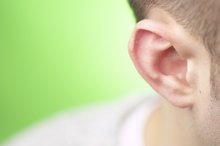Causes of Chronic Ear Popping
To understand how certain conditions can cause ear popping, you need to understand a bit about how your ears work. Your ear comprises the external, middle and inner ear. Sound waves travel from your external ear to the eardrum. The waves trigger eardrum vibrations that set into motion three tiny bones in the middle ear. The last bone taps on a membrane, transmitting the sound signals to the inner ear. To set the hearing cascade in motion, the eardrum must be able to vibrate freely. The eustachian tube -- which runs between the middle ear and rear area of the nose -- helps ensure eardrum mobility by keeping the pressure in the middle equal to that of the ambient air and allowing middle ear secretions to drain. Chronic ear popping usually signals disruption in these functions, or eustachian tube dysfunction (ETD) 234. Several conditions can cause chronic ETD.
If you are experiencing serious medical symptoms, seek emergency treatment immediately.
Nasal Allergies
From a medical perspective, chronic ETD means symptoms lasting more than three months. Nasal allergies are a leading cause, especially nonseasonal allergies such as to dust mites, mold spores and pet dander. The allergic reaction triggers inflammation, congestion and swelling of the nasal lining tissue that can block the eustachian tube. This leads to negative pressure in the middle ear, which tamps down eardrum vibrations in response to sound waves. A popping sound occurs when the tube suddenly snaps open, relieving the negative pressure in the middle ear. Most people notice everything sounds louder and clearer when the ear pops because relieving the negative pressure allows the eardrum to move freely again. Chronic ear popping due to nasal allergies usually responds well to treatment of the underlying allergies.
- From a medical perspective, chronic ETD means symptoms lasting more than three months.
- A popping sound occurs when the tube suddenly snaps open, relieving the negative pressure in the middle ear.
Chronic Sinusitis
Allergy Symptoms and Clogged Ears Immediately After Eating
Learn More
Chronic sinusitis desribes inflammation of the tissue lining the nose and one or more sinuses for longer than three months. As with nasal allergies, inflammation of the nasal tissue often leads to ETD and chronic ear popping. Chronic sinusitis can develop due to a bacterial or fungal infection, or in response to ongoing exposure to nasal irritants, such as tobacco smoke. Gastroesophageal reflux disease, commonly known as GERD, might also contribute to the development of chronic sinusitis. Typical symptoms include nasal congestion, postnasal drip, thick nasal discharge and facial pain or pressure.
- Chronic sinusitis desribes inflammation of the tissue lining the nose and one or more sinuses for longer than three months.
- As with nasal allergies, inflammation of the nasal tissue often leads to ETD and chronic ear popping.
Nasal Growths
The adenoids are paired tissue clusters at the back of the nose. Like the tonsils in the throat, the adenoids are part of the immune system and help fight infections. Enlargement of the adenoids due to upper respiratory infections can block the nasal openings of the eustachian tubes, leading to ETD and ear popping. Children are more likely than adults to develop ETD due to adenoid enlargement.
Other nasal growths near the eustachian tube openings, including polyps and noncancerous or cancerous tumors, can similarly lead to blockage of the eustachian tubes and ETD. In contrast to adenoid enlargement, these conditions primarily affect adults.
- The adenoids are paired tissue clusters at the back of the nose.
- Enlargement of the adenoids due to upper respiratory infections can block the nasal openings of the eustachian tubes, leading to ETD and ear popping.
Other Causes
Exercises to Unblock Ears
Learn More
Several other conditions can potentially lead to chronic ear popping, including:
- Cleft palate and other facial malformations
- Nasal or facial trauma
- Cystic fibrosis
- Temporomandibular joint dysfunction, commonly known as TMJ
- Obesity
See your healthcare provider if you experience chronic ear popping. While you may not realize it, chronic ETD often causes some hearing loss. In most cases, this is reversible with treatment of the underlying ETD. See your doctor as soon as possible if your ear popping is accompanied by any warning signs or symptoms, including:
- Fever or chills
- Fluid draining from the ear
- Sudden hearing loss
- Severe or worsening ear pain
Reviewed and revised by: Tina M. St. John, M.D.
- See your healthcare provider if you experience chronic ear popping.
- See your doctor as soon as possible if your ear popping is accompanied by any warning signs or symptoms, including: * Fever or chills
* Fluid draining from the ear * Sudden hearing loss * Severe or worsening ear pain Reviewed and revised by: Tina M. St. John, M.D.
Related Articles
References
- Clinical Otolaryngology: Eustachian Tube Dysfunction: Consensus Statement on Definition, Types, Clinical Presentation and Diagnosis
- Epocrates: Eustachian Tube Dysfunction
- Family Practice Notebook: Eustachian Tube Dysfunction
- 5-Minute Clinical Consult: Eustachian Tube Dysfunction
- Clinical Advisor: Chronic Dysfunction of the Eustachian Tube
- Current Allergy and Asthma Reports: The Etiology and Pathogenesis of Chronic Rhinosinusitis: A Review of Current Hypotheses
- Szymanski A, Agarwal A. Anatomy, Head and Neck, Ear Eustachian Tube. National Center for Biotechnology Information. Updated December 6, 2018.
- Szymanski A, Agarwal A. Anatomy, Head and Neck, Ear Eustachian Tube. National Center for Biotechnology Information. Updated December 6, 2018.
- Llewellyn A, Norman G, Harden M, et al. Interventions for adult Eustachian tube dysfunction: a systematic review. Health Technol Assess. 2014;18(46):1-180, v-vi. doi:10.3310/hta18460.
- Casale J. Physiology Eustachian Tube Function. National Center for Biotechnology Information. Updated October 27, 2018.
- Smith ME, Takwoingi Y, Deeks J, et al. Eustachian tube dysfunction: A diagnostic accuracy study and proposed diagnostic pathway. PLoS ONE. 2018;13(11):e0206946. doi:10.1371/journal.pone.0206946.
- Merck Manual Consumer Version. Overview of Middle Ear Infections in Young Children. Updated February 2019.
- Genetic and Rare Disease Information Center. Patulous Eustachian Tube. Updated May 21, 2016.
Writer Bio
Dr. Tina M. St. John owns and operates a health communications and consulting firm. She is also an accomplished medical writer and editor, and was formerly a senior medical officer with the U.S. Centers for Disease Control and Prevention. St. John holds an M.D. from Emory University School of Medicine.








